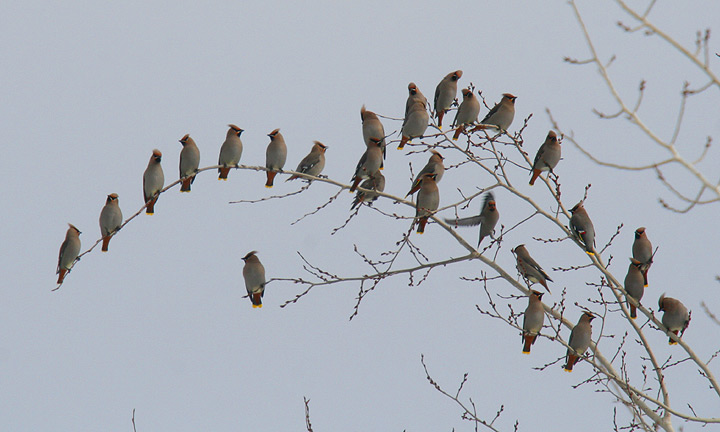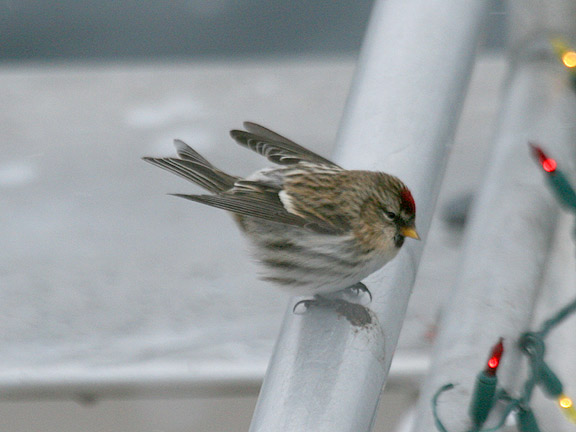Well, here we are just a couple days from Christmas and aside from the initial 3 reports there hasn't been a peep about Bohemians. So what happened?
It's hard to say.
The lack of any more reports seems to coincide with the arrival of several large winter storms that pounded the northern half of the state in late November. We often associate the movements of birds with weather, but in the case of this species the movement is almost strictly food related.
I guess the important question is: were the birds going to irrupt this year? I remember thinking in the past that this species was cyclical in winter arrivals—being seen every other winter in Utah. However looking at the past 6 years, that doesn't seem to line up:
2005-2006 irruption winter
2006-2007 no irruption
2007-2008 irruption winter
2008-2009 no irruption
2009-2010 no irruption
2010-2011 no irruption
We are now on to the 3rd winter in a row without an irruption. Perhaps the few reports were isolated wandering flocks, and an irruption wasn't going to happen. Ron Pittaway mentioned in his "Winter Finch Forecast" that it didn't seem like a good year for them to wander in Canada. Often his forecast is valuable in predicting what types of finches and other winter songbirds might show up in Utah. Obviously we are a long way from Ontario where the forecast is based, and some of the food conditions are different here—but for species that breed across Canada and winter there too, the information can be quite informational.
That being said, this may not have been the winter for an irruption—despite those early reports. With waxwings seeming like they won't make any mass appearances, I look to January and the possibility of Redpolls. According to the same forecast,
"Redpolls in winter are a birch seed specialist and movements are linked in part to the size of the birch crop. The white birch crop is poor across much of northern Canada. Another indicator of an upcoming irruption was a good redpoll breeding season in 2010 with double and possibly triple broods reported in Quebec…"
And along with Common Redpoll come the inevitable chance for Hoary Redpoll, a bird that most Utah birders have not seen in state. Now if you are wondering, "where are the redpolls?" just hold on for a month. Literally.
Looking at past records for redolls in Utah there is a wide array of months with sightings, starting in October and going all the way to March. Most records appear to be from December CBC results, many of which have no documentation—leaving the sightings questionable. A number of documented sightings come from January and February across the northern reaches of the state—seemingly the best time to find a Redpoll in Utah. The only accepted Hoary Redpoll record was in February 1999 in Cache County.
All this being said, now is about the perfect time to start watching those feeders closely, and checking flocks of finches and siskin to see what turns up. Cache County is one of the places where Redpolls should arrive first, and in the past this has been the hub for them during irruption years. From there we can always hope they move south along the Wasatch Front.
Who knows, maybe the redpolls will make up for the waxwings disappointing showing. I personally have high hopes, and if all else fails, spring is just around the corner, followed by songbirds heading north.



3 Comments:
Interesting read. The winter finch forecast seems to be a pretty accurate indicator of what might happen elsewhere. It seems like in years past some of the predictions certainly matched up with movements here in the states. Is there information more local to Utah, the Rocky Mountain Region, or even the US? It would seem like something that would be even more useful that would go hand in hand with the Pittaway report.
Tom, I don't know of anything like the Pittaway Finch Forecast for the US, or even more local. Information about seed crops that finches use in the Mountain West could indeed be beneficial to predicting what type of movements might occur. I would guess you could probably approach the Department of Natural Resources to get pointed in the right direction towards information about seed crops of certain types of spruce and pine each year. Then its just a matter of matching that information up with the birds that use them and making predictions about what might happen.
Recording success in Cryptocurrency, Bitcoin is not just buying and holding till when bitcoin sky-rocks, this has been longed abolished by intelligent traders ,mostly now that bitcoin bull is still controlling the market after successfully defended the $60,000 support level once again and this is likely to trigger a possible move towards $100,000 resistance area However , it's is best advice you find a working strategy by hub/daily signals that works well in other to accumulate and grow a very strong portfolio ahead. I have been trading with Mr Bernie doran daily signals and strategy, on his platform, and his guidance makes trading less stressful and more profit despite the recent fluctuations. I was able to easily increase my portfolio in just 1week of trading with his daily signals, growing my $3000 to $25,000 Mr Bernie’s daily signals are very accurate and yields a great positive return on investment. I really enjoy trading with him and I'm still trading with him, He is available to give assistance to anyone who love crypto trading and beginners in bitcoin investment ,he can also help you recover your lost funds I would suggest you contact him on WhatsApp : + 1424(285)-0682 , Gmail : (BERNIEDORANSIGNALS@GMAIL.COM) or Telegram : @IEBINARYFX for inquiries
Post a Comment
Subscribe to Post Comments [Atom]
<< Back to Previous